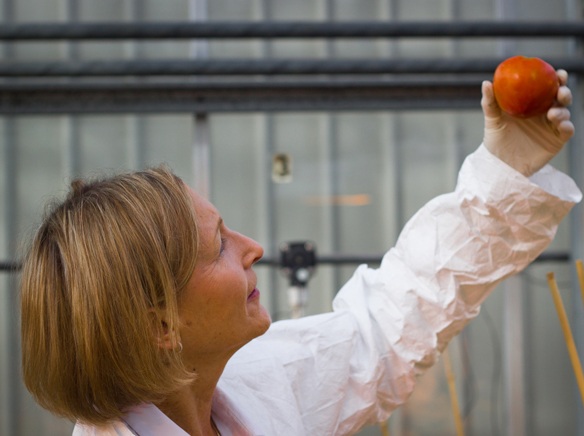A former Rossmoor resident and graduate of Los Alamitos High school, Barbara Baker, Ph.D., has been elected by her fellow scientists to the National Academy of Sciences, one of the highest honors in science.
Baker was selected in a vote by the Academy’s scientists, which now includes approximately 2500 of America’s leading scientists, and 500 others around the world.
“I did not expect it,” said Baker, “and of course, I’m completely thrilled.”
Baker is currently an Adjunct Professor at the University of California, Berkeley, in the Department of Plant and Microbial Biology, and a Senior Scientist at the Plant Gene Expression Center at the USDA Agricultural Research Service in Albany, CA. Her findings have been described as “breakthrough research”.
With her election to the National Academy, Baker is now considered to be one of the world’s foremost scientists studying plant biology and microbial sciences.
According to the USDA, Dr. Baker’s research was the first to reveal that R-genes, and the proteins they encode, form a major plant defense system against a broad spectrum of plant pathogens including bacteria, viruses, and fungi.
Baker has spent much of her academic life chasing microbes as a way to mitigate plant diseases that sometimes kill as much as 40 percent of crops around the world.
In addition, she has performed countless experiments in her molecular biology lab, examining plants and observing them intently in her quest to change the paradigm for genetic protection of living plants.
Baker’s academic universe revolves around the study of molecular particles that are not only too small for the human eye to see, but in fact, too small even to be seen under a light microscope. She used molecular techniques to eventually isolate disease resistant genes.
According to Baker, plant genomes contain large numbers of R-genes and each encodes for an R protein that recognizes a specific pathogen signature and triggers resistance responses to different pathogen strains.
“It’s complicated,” said Baker, but basically, plants, like humans, have their own DNA.
Over time, she said, “humans have had a big impact” on the plants from which we now harvest most of our food. Take for an example, a simple tomato plant, said Baker, citing the breeding that began with a plant in nature for which breeding has led it far from its original, natural molecular composition.
During the past hundred years, which some call the modern era of plant genetics, “we’ve scrambled some of the plant gene pool,” she suggested, leaving plants vulnerable to disease.
Baker said her work has focused on isolating plant genes in nature that are capable of providing natural resistance to crops.
According to Baker, plants also suffer from viruses as the coronavirus has affected people around the world, although she said plant viruses do not infect humans and vice versa.
In the lab, however, she said not all viruses look the same. And despite their potential for devastation, Baker said viruses “are absolutely remarkable, with incredible and beautiful structures.”
Baker’s interest in biology and physics go back to high school here in Los Al, when she said Los Alamitos High physics teacher Wesley Beach and biology teacher Mr. Rogers put her on her current career path. “They inspired me,” she said.
Baker, a 1970 LAHS graduate, began her scientific career as an undergraduate in the Department of Biology at the University of California, San Diego where she worked on virus replication and expression.
She did her graduate training in the Department of Microbiology and Immunology at the University of California, San Francisco where she received her Ph.D. on Endogenous Avian Retroviruses with Drs. Mike Bishop and Harold Varmus.
Baker then accepted a postdoctoral fellowship to live and work at the internationally renowned Max-Planck Institute in Germany, considered by many as the training ground for the world’s leading scientists.
It is here that Baker said she became immersed in the study of submicroscopic viruses. Eventually returning to the U.S. to begin teaching virology and plant-virus interactions at Berkeley and as a scientist with the USDA Agricultural Research Service.
In fact, in the early 1900’s, historians say Albert Einstein debated his theory of relativity with Max Planck, a theoretical physicist who discovered the quantum of action, in what is now an institute named in Planck’s honor.
After completing her postdoctoral training Baker said she was hired on as both a faculty member at UC Berkeley, and a Senior Scientist at USDA, her dream job.
“I’ve always wanted to live and study in the bay area,” she said.
There, she met outstanding colleagues active in the field of plant genetics and plant molecular biology including some who studied plant viruses.
Her achievement comes after a long career studying molecular mechanisms and looking for a specific type of gene that plants use “to fight viruses.” She said when crops are lost, it is not only a waste of food, but also a tremendous loss of water, fertilizers, and other farm resources.
Plant pathogens reduce crop production globally by 10-40 percent each year. These pathogens are continually evolving and overcoming existing innate, genetic resistance in crops. Plants also continually co-evolve, producing new R-genes in response. But the natural process of playing catch up can be too slow in modern agriculture.
By eventually isolating “resistance genes,” Baker said, “we knew what to look for and how to work with other resistance genes, that encode resistance proteins that make the cell and eventually the plant, resistant to disease.”
According to the USDA, advances prompted by Baker’s work have allowed plant scientists and breeders to speed up the process of introducing new disease resistance genes into crops.
For example, in a crop such as potatoes, R-genes from wild relatives were transferred into a cultivated potato where they protect it from late blight disease (caused by the pathogen Phytophthora infestans, the cause of the Irish Potato Famine of the mid 1800’s and that still plagues our crops).
Her research group continues to work on molecular mechanisms of host-pathogen interactions, including identification, isolation, and characterization of genes that naturally protect crops from common diseases using crop species of Solanaceae family as plant models.
In 2003, her program was awarded the UC Berkeley Chancellor’s Honor Award as an exemplary University/Community Partnership.
“This work has been so exciting and thrilling for me,” said Baker, fondly recalling her days at Los Al high school and spending her summers frolicking around Seal Beach.
Incidentally, Baker’s mom, Mary Baker, served as Assistant Superintendent of the Los Alamitos Elementary School District before the district was unified.
“I am really, really pleased and honored,” said Baker. There is no financial benefit of being elected, she said, “and you don’t get a parking pass, but it does make me so inspired, even more driven.”
The latest group of scientists elected includes 59 female scientists, a record.
In a statement, National Academy of Sciences President Marcia McNutt said, “the historic number of women elected this year reflects the critical contributions that they are making in many fields of science, as well as a concerted effort by our Academy to recognize those contributions and the essential value of increasing diversity in our ranks.”
The National Academy of Sciences is a nonprofit, non-governmental organization that is part of the National Academies of Sciences, Engineering, and Medicine.
The prestigious research institution dates to 1863. It was created after a resolution authored by Senator Henry Wilson was passed by the United States Senate and was signed into law by President Abraham Lincoln.
Editor’s Note: The Fort Worth based think tank, Academic Influence, has this week included Los Al High School in its ranking of America’s top 50 high schools “whose alumni have exhibited the most influence post-graduation.”




